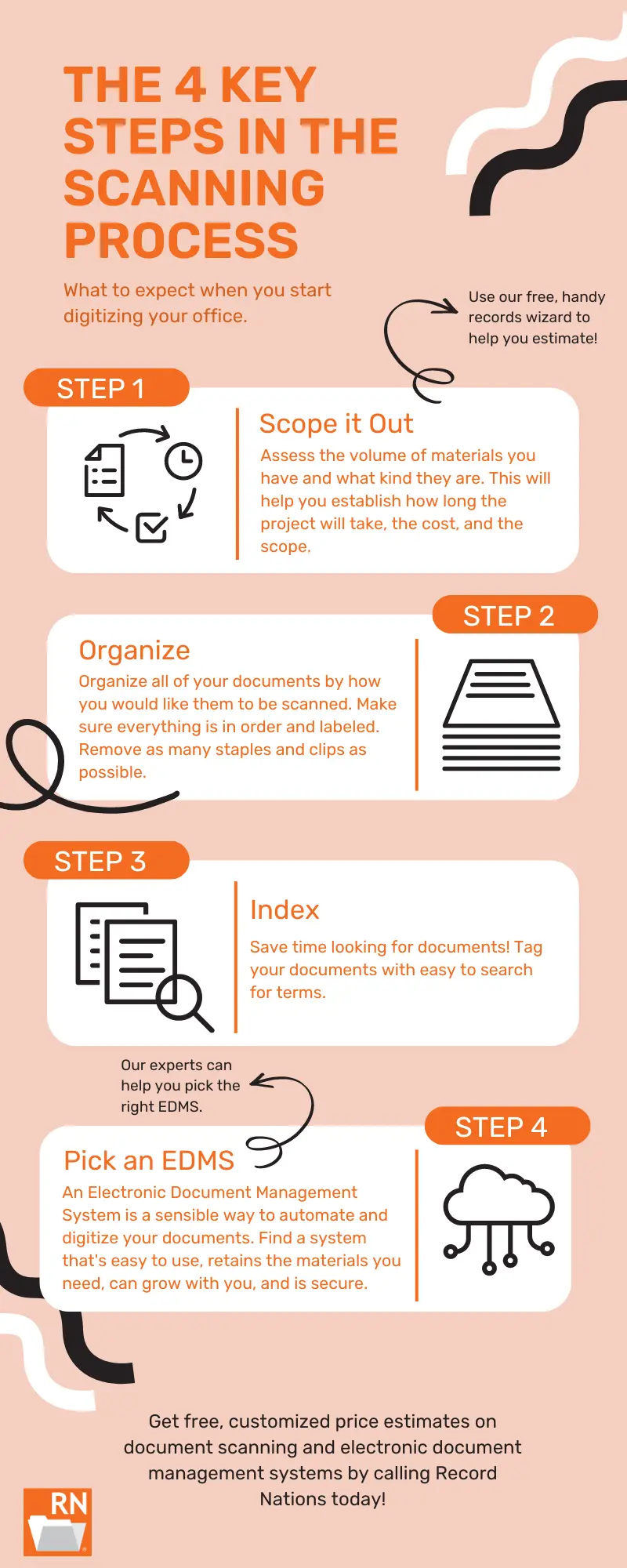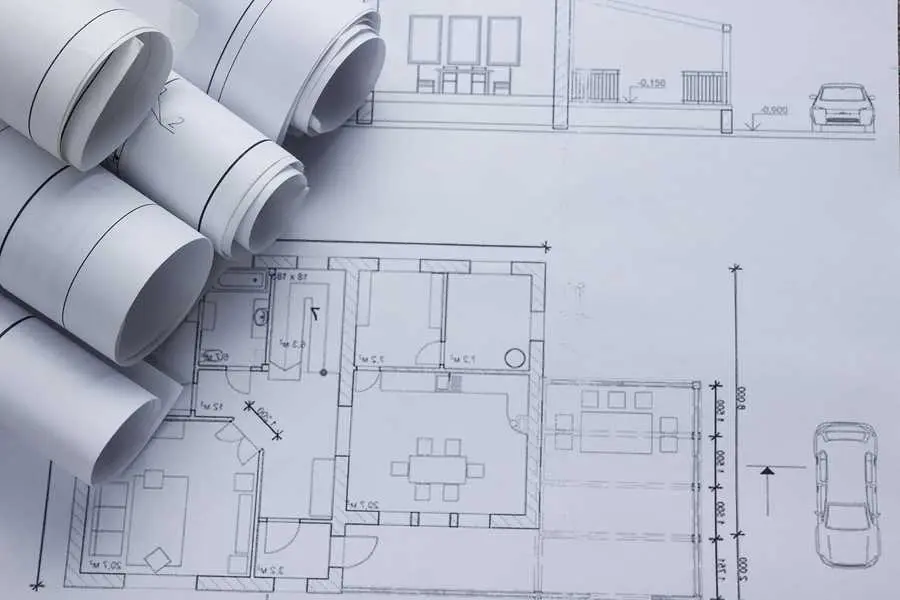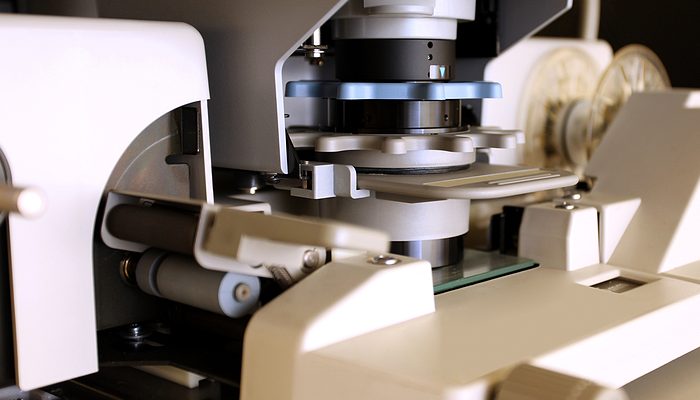Professional Document Scanning, On Demand
Our nationwide network of document management companies can take on records scanning and storage projects of any size, on- or off-site.
Contact us and be matched with a human expert in minutes.
A Nationwide Resource for Scanning and Storage Projects
Widest Coverage Area
With a reliable provider network that spans the U.S. & Canada, Record Nations can support on- or off-site scanning projects anywhere you need it done.
Decades of Experience
Benefit from our 20+ years of document management experience, innovation, and intimate knowledge of industry providers, standards, and best practices.
Flexible Scanning Solutions
Record Nations provides individuals and businesses alike with multiple quotes and tailored solutions for document scanning projects of any size, any shape, anywhere.
Secure Document Storage
Maintain your original records in off-site storage while accessing your data online.
We’ll match you with providers familiar with the compliance standards and challenges in your industry.
A Reliable Document Management Partner
Very happy with this whole experience!"
Super happy with the customer service!"
Our Document Scanning and Storage Services

Document Scanning
Spend less time digging and more time doing with document scanning services.

Document Storage
Save space — mentally and physically — with secure document storage.

Secure Document Destruction
Keep your information out of the wrong hands with secure document destruction.

Cloud Storage
Security, accessibility, compliance — our cloud storage services check all the boxes.
Getting Started with Professional Document Scanning
Not sure where to begin? Our in-house document management team can help with projects of any size.
- Determine the type and volume of documents you have. Confirm priority and any special sizing, retention, or security requirements they have.
- Reach out to Record Nations to connect with local providers. Secure free quotes and choose the provider that works best for you.
- Schedule your service with your chosen provider. Prepare your documents for handoff and wait for them to be scanned.
- Benefit from easy retrieval in the format of your choice. Original documents can be returned, securely stored, or safely shredded.

Find Large Format Scanning Services
From architectural drawings to schematics and maps, Record Nations can convert them all for you. Our large format scanning services streamline access, organization, and compliance so you can focus on what matters most.
- Determine the type and volume of large documents you have. Confirm priority and any special sizing, retention, or security requirements they have.
- Reach out to Record Nations to connect with local providers. Secure free quotes and choose the provider that works best for you.
- Schedule your service with your chosen provider. Prepare your large documents for handoff and wait for them to be scanned.
- Benefit from easy retrieval in the format of your choice. Originals can be returned, securely stored, or safely shredded.
Local Blueprint Scanning Services
Spend your time drafting, not chasing down old plans. With Record Nations’ blueprint scanning services, all your blueprints are converted to digital files for convenient searching, easier sharing, and streamlined storage.
- Determine the type and volume of blueprints you have. Confirm priority and any special sizing, retention, or security requirements they have.
- Reach out to Record Nations to connect with local providers. Secure free quotes and choose the provider that works best for you.
- Schedule your service with your chosen provider. Prepare your blueprints for handoff and wait for them to be scanned.
- Benefit from easy retrieval in the format of your choice. Original blueprints can be returned, securely stored, or safely shredded.

Microfilm & Microfiche Scanning Services
Still using outdated methods to preserve your media? Record Nations’ microfilm and microfiche scanning services safely convert your fragile memories into digital files so quality is maintained and they’re accessible for years to come.
- Determine the type and volume of files you have. Confirm priority and any special sizing, retention, or security requirements they have.
- Reach out to Record Nations to connect with local providers. Secure free quotes and choose the provider that works best for you.
- Schedule your service with your chosen provider. Prepare your files for handoff and wait for them to be scanned.
- Benefit from easy retrieval in the format of your choice. Original files can be returned, securely stored, or safely shredded.

Frequently Asked Questions
Document Scanning
What is document scanning?

Document scanning is the process of converting physical documents into digital format. It involves using a scanner or specialized equipment to capture images of paper documents and store them as electronic files.
How much do scanning services cost?

On average, it will cost around 7-12 cents per page. The price will vary on the type of document, size of your project, the complexity, any features you add on, and if you would like to implement any of our storage options.
What Is the lead-time to schedule a service?

When you submit a quote request or give us a call, we can help match you to a provider within just a few minutes. Our process is quick and efficient! You can expect us to ask a few questions regarding your needs and specific location, and we will work our magic to see what provider best fits your needs. Usually, you will receive quotes from our recommended providers within a few minutes to a few hours. They will provide you with exact quotes on your project.
Why should I scan my documents?

Scanning documents offers several benefits, including reducing physical clutter, making documents searchable, enabling easy backups, and enhancing document accessibility and sharing. It also helps in disaster recovery and saves physical storage space.
What are the benefits of scanning services?

Increase Efficiency & Improve Workflow – The documents and files that you scan can be integrated into digital workflows, streamlining business processes and reducing manual data entry and paperwork. This can lead to faster decision-making and improved customer service.
Enhance Security & Disaster Recovery – Scanned documents can be encrypted and backed up, enhancing data security and providing safeguards against physical document loss due to disasters like fire, floods, or theft. In addition, you can set up access controls to verify who can view which files.
Improve Accessibility & Collaboration – Digital documents can be accessed remotely, making it easier for employees to work from different locations or access important information while on the go. In addition, multiple employees can easily share and work on the same file at once.
Optical Character Recognition – With OCR scanning, your files can be easily searched for and edited as soon as it’s uploaded into your files or document management system.
Improve Document Retrieval – Scanned documents are indexed and can easily be searched and retrieved using keywords or metadeta. This eliminates the need for manual searching through paper files, saving time and improving productivity.
What types of documents can be scanned?

Almost any type of document can be scanned, including paper documents; photographs; large format documents; medical records; legal documents; financial records; blueprints; microfilm and microfiche; X-rays; and more.
Document scanning services can handle documents of different sizes, shapes, and formats.
What’s the turnaround time on a scanning project?

The timing on your scanning project can depend on a number of variables, including the complexity, quantity, and specific requirements (indexing, redacting, etc). This is a question that our service providers would be able to answer more in depth. Many of our providers can handle projects pretty quickly, but this can vary by provider, season, and timeline needed.
After connecting with us, we can help you figure out what timing is best for both parties.
What file formats are supported for scanned documents?

Our network of service providers supports a variety of file formats, including PDF, TIFF, JPEG, and more. They can work with you to ensure compatibility with your systems.
How do I calculate the number of documents I have to scan?

With our easy-to-use conversion calculator, you can determine how many boxes of paper you have based on your current method of storage.
If you need additional help, give us a call and we can walk you through it.
Is there a size limit for documents that can be scanned?

Our service providers can accommodate a wide range of document sizes, from small receipts to large format drawings. They have versatile scanning equipment and can customize their services to meet your specific needs.
Do I need to prepare the documents before sending them for scanning?

In general, documents should be organized and free from any debris or damage. Staples, paperclips, and other bindings should be removed to ensure the scanning process is smooth and efficient.
Can you scan double-sided documents?

Yes – our service providers’ scanners are equipped to scan both sides of papers at the same time. Your documents will only pass through the scanner once.
How does indexing work?

Document indexing is when you associate or tag documents with different “search terms.” You will be able to easily search for files using the keywords of your choice. Some examples you can index by are case number, dates, patients’ names, invoice number, order numbers, addresses, and more.
What is the difference between imaging and digitizing?

Document imaging takes a digital “image” copy that is only readable. Digitizing typically incorporates OCR scanning that allows you to edit your digital documents.
Do you offer OCR (Optical Character Recognition) services for scanned documents?

Yes, our local providers offer OCR services to convert scanned images into searchable and editable text, enhancing the usability of your digitized documents.
What is day-forward scanning?

With day-forward scanning, you select a future date when you will first scan your archives of existing documents. From that date on, your new documents will be scanned as soon as they are created.
Can I access my scanned documents or stored records remotely?

Yes, many of our partner document scanning and records storage providers offer remote access solutions, such as cloud-based platforms or secure online portals, for convenient document retrieval.
Is it better to scan documents with phone or scanner?

Documents scanned by a scanner are generally better. These files, when scanned professionally, are clear, high-resolution, easy to upload to an electronic document management system, sharable, and highly secure. Professional scanning is a quick and affordable process through Record Nations. Let us help you find providers in your area
Do you offer on-site document scanning services, or do we need to send our documents to your facility?

Most of our partners offer both on-site and off-site scanning services. Depending on your preference and the volume of documents, they can tailor their services to meet your specific requirements.
How does walk-in scanning work?

Here is a general overview on how walk-in scanning works:
1) Gather your physical documents.
2) Visit a walk-in document scanning service center.
3) Pay the service fee (usually a per page price)
4) Hand over your documents to the service center personnel.
5) Trained personnel will scan your documents using professional equipment.
6) Receive the digital files based on your chosen delivery method.
What happens to my original paper records after scanning?

After scanning, your records can be securely store, return to you, or securely destroyed, depending on retention times. If you choose storage, we have providers that can assist with keeping them in a controlled and secure environment.
How secure is the scanning process?

The level of security in the scanning process depends on the document scanning service. Our service providers are reputable and ensure the utmost security measures throughout their practices. We at Record Nations prioritize confidentiality and integrity through measures such as physical security, restricted access, encryption, and secure destruction of original documents. For medical records, the security of patient data is the top priority. Our partners adhere to strict HIPAA (Health Insurance Portability and Accountability Act) compliance standards and have robust security measures in place to safeguard medical records.
Are there any legal or compliance considerations I should be aware of when digitizing my documents?

Our service providers are well-versed in legal and compliance standards. They ensure that their scanning processes adhere to industry regulations and can provide guidance on specific considerations relevant to your business or industry.
What industries can benefit from scanning services?

All industries can greatly benefit from our scanning services. Some industry-specific examples include: Medical, Legal, Buisness, Financial, Insurance, Government, Education, Human Resources, Automotive, Real Estate, Construction, Transportation, Manufacturing, Agriculture, Energy, Hospitality, and More!
What is the purpose of medical records scanning, and how can it benefit our healthcare facility?

Medical records scanning converts paper-based medical records into digital formats, improving access, retrieval, and patient care. Benefits include reduced storage costs, enhanced data security, and streamlined record management.
Are there any size or quantity limitations for medical records scanning projects?

Our network of providers can accommodate medical record projects of various sizes, from small practices to large healthcare facilities. Get in touch with us to discuss the specific requirements of your medical records scanning project and connect with the right local provider.
Do you offer OCR (Optical Character Recognition) services for medical records?

Yes, our local providers offer OCR services for medical records to convert scanned images into searchable and editable text, enhancing the usability of digitized patient information.
Large Format Scanning
What is considered a large format document?

Any document that is larger than the standard-sized paper (8.5″ x 11″) is considered large format. Common examples include blueprints, architectural drawings, engineering diagrams/drawings, maps, schematics, sketches and artwork, building plans/drawings, etc.
Is there any prep work that needs to be done before scanning my large format documents?

Your large format documents need to be removed from tubes, racks, rubberbands, or any other type of binding
How long will a large format scanning service take?

Large format documents will take a little bit longer than a normal document scanning project because of their size. A large flatbed scanner can only handle one document at a time. Additionally, our service providers know that these types of documents need special care and proper handling to avoid rips and tears during the process.
How much will a large format scanning service cost?

The price will depend on numerous factors such as document condition and any prep work, the required resolution, indexing, how many you have, and any other special requests such as expedited turnaround time.
How are large format documents scanned?

Oversized flatbed scanners are necessary for handling large-format documents. Known as wide-format or large-format scanners, these machines can scan such documents in a single pass. These wide-format scanners are capable of providing the necessary resolution needed for large-format documents, ensuring the preservation of every intricate detail during scanning.
How secure are your large format scanning services?

Security level will vary depending on the type of document you need to be scanned, but our service providers prioritize confidentiality and integrity. They are all compliant with state and federal privacy laws, such as HIPAA, HITECH, FACTA, and more, and have physical security, restricted access, and encryption, and can securely destroy your documents after scanning if needed.
Can I edit my large format documents after they're scanned?

When you request OCR scanning, your blueprints and drawings will be converted to machine-encoded text that can be edited through a PDF.
What format will my digital large format documents be returned in?

Our service providers support a variety of file formats, including PDF, TIFF, JPEG, and more. They can work with you to ensure compatibility with your systems.
Do you offer on-site scanning for large format documents?

Most of our partners offer both on-site and off-site scanning services. Depending on your preference and the volume of documents, they can tailor their services to meet your specific requirements.
What additional services are offered for large format documents?

Our service providers offer additional services like document indexing, metadata tagging, or even integration with document management systems. Additionally, OCR technology can be beneficial for making scanned large format files searchable and editable. Check for these options based on your needs.
Bluepring Scanning
How do blueprint scanning services work?

1. Give Record Nations a call at (866) 385-3706 or fill out the form to connect to one of our experts.
2. You will receive several free quotes from service providers in your area. Choose the provider that best meets your budget.
3. Gather and organize your blueprints for scanning. Remove any unneccessary bindings or restricting material so the project can move quickly and easily.
4. Your provider will scan your blueprints onsite or offsite and complete the process. You will then get to choose how to store them if you want to destroy them or add ongoing scanning services.
Is there any prep work that I need to do before I give my blueprints to my service provider?

Your blueprints need to be removed from tubes, racks, rubberbands, or any other type of binding.
What types of blueprints can be scanned?

Most blueprint scanning services can handle a variety of documents, including architectural drawings, engineering plans, maps, and other large-format documents.
What file formats are available for scanned blueprints?

Blueprints can be scanned and saved in a variety of formats including PDF, TIFF, JPEG, and more, depending on your preferences and requirements.
How secure are blueprint scanning services?

Our reputable blueprint scanning providers have protocols in place to ensure the confidentiality and security of your sensitive documents. This may include secure handling, data encryption, and confidentiality agreements. Additionally, all of our service providers follow all state and federal privacy regulations.
How much will a blueprint scanning service cost?

The price of your project will depend on the number of pages, the complexity of the blueprints, or other factors. Also, inquire about any additional fees that might apply.
How long will my blueprint scanning service take?

Since blueprints are typically large format, your project will take longer than regular documents because of their size. Flatbed scanners can only handle one document at a time. Additionally, our providers know these documents need special care and proper handling to avoid rips and tears during the process.
Are there any additional services provided for blueprints?

Our service providers offer additional services like document indexing, metadata tagging, or even integration with document management systems. Additionally, OCR technology can be beneficial for making scanned blueprints searchable and editable. Check for these options based on your needs.
Microfiche and Microfilm
What is microfilm?

Microfilm, alternatively referred to as roll film, is available either in an open reel format or within a cassette. Typically, roll film is supplied in lengths of 100 feet for 35mm film, 130 feet for 16mm film, and 215 feet for 16mm film. Microfilm is typically made from a polyester base coated with a light-sensitive emulsion.
Documents are photographed onto the film using a microfilm camera, which captures high-resolution images at a reduced size. The film is then processed using chemical development techniques similar to those used for traditional photography. Once processed, microfilm reels or sheets can store hundreds or even thousands of pages of documents in a space-saving format. Microfilm is commonly used for long-term preservation of archival materials, such as newspapers, manuscripts, government records, and other important documents.
What is microfiche?

Microfiche is a format for storing multiple pages of documents in a compact form on a single sheet of film. The film sheet typically measures about 4 x 6 inches and contains microphotographs of documents arranged in a grid pattern. Each individual document is reduced in size and arranged in rows and columns on the microfiche, allowing multiple documents to be stored on a single sheet.
Microfiche is commonly used for archiving and storing large volumes of documents, such as library catalogs, newspapers, periodicals, and technical manuals. It offers several advantages, including space efficiency, as many pages can be stored on a single microfiche sheet, and durability, as the film is resistant to deterioration from environmental factors.
What is COM fiche?

COM fiche, short for Computer Output Microfilm fiche, refers to microfilm created from a mainframe data stream or print file. Usually, COM fiche consists of a sequence of images produced at a reduction ratio of either 24X or 48X.
What is an aperture card?

An aperture card is a type of punched card used for storing microfilm images, particularly in technical fields such as engineering, architecture, and manufacturing. The card consists of a sturdy piece of cardboard or paper with one or more cut-out windows, or “apertures,” typically located near one edge of the card. These apertures hold small sections of microfilm containing images of technical drawings, schematics, or other documents.
Why should I consider microfilm and microfiche scanning services?

Our scanning services help in digitizing and preserving historical or important documents stored on microfilm or microfiche, making them more accessible and reducing the risk of deterioration.
What types of microfilm can be scanned?

Scanning services may handle various microfilm and microfiche formats, including 16mm and 35mm microfilm, and aperture cards.
How much will microfilm scanning cost?

The price of your project will be based on the number of frames, the type of microfilm, final resolutions, indexing requirements, or other factors. Once you contact us with the details of your project, our service providers will give you a more accurate price quote.
How should I store my microfilm before scanning?

Proper storage of microfilm before scanning is crucial to ensure that the film remains in good condition and that the resulting scans are of high quality. Here are some guidelines for storing microfilm before scanning:
-
Temperature and humidity control: Store microfilm in a climate-controlled environment with stable temperature and humidity levels. Ideal conditions are typically around 20-24°C (68-75°F) and 30-50% relative humidity.
-
Protection from light: Microfilm should be stored in light-tight containers or cabinets to prevent exposure to sunlight or artificial light, which can cause fading and degradation of the images.
-
Dust and dirt prevention: Keep microfilm reels or sheets in protective sleeves or containers to shield them from dust, dirt, and other contaminants. Clean the storage containers regularly to prevent buildup.
-
Avoiding extreme conditions: Avoid storing microfilm in areas prone to extreme temperatures, high humidity, or fluctuations in environmental conditions, as these can accelerate degradation.
-
Proper handling: When handling microfilm, wear clean, lint-free gloves to prevent fingerprints and oil transfer. Handle the film gently and avoid bending or creasing it.
-
Organization: Keep microfilm reels or sheets organized and labeled to facilitate easy retrieval when it’s time for scanning. Use archival-quality labels and markers to avoid damage to the film.
-
Regular inspection: Periodically inspect stored microfilm for signs of deterioration, such as vinegar syndrome (a chemical degradation process), mold growth, or physical damage. Address any issues promptly to prevent further deterioration.










All around very pleasantly surprised at how quickly and professionally I was able to get everything lined up."